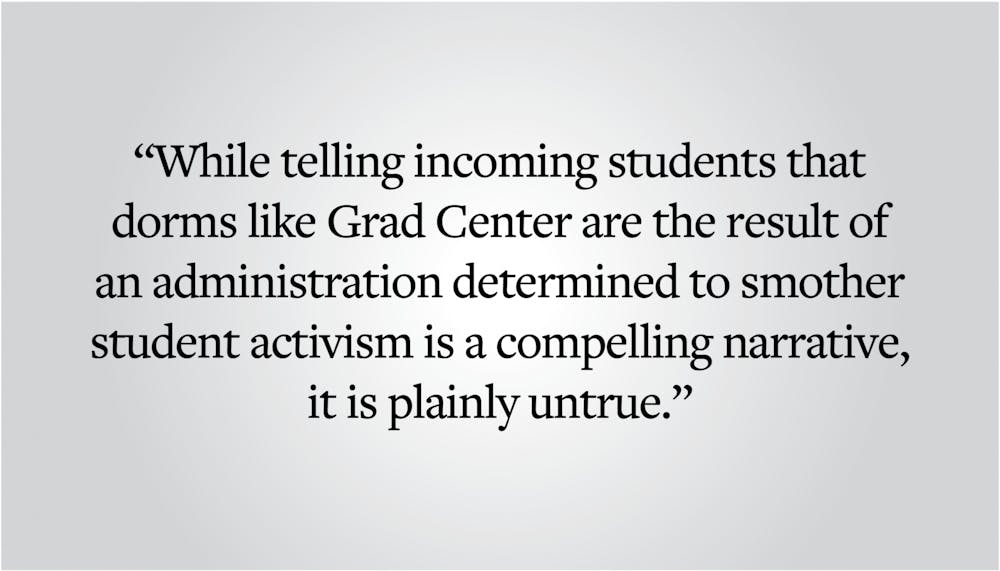The Sciences Library, the John D. Rockefeller Jr. Library, the List Art Center, Graduate Center — these brutalist buildings have a defined presence on campus, even if their aesthetics are highly controversial. Some hate the sight of Grad Center's concrete walls while others praise the striking beauty of the SciLi. Whether you love them or hate them, many of us have been told by campus publications and upperclassmen that our brutalist dorms were built with the nefarious purpose of preventing student riots. The idea is that the tight corridors, confusing layouts and awkwardly placed entrances would prevent students from storming through the buildings. While this is an entertaining way to explain the irregularities of these buildings, it is plainly a myth. Though it is convenient to believe that a cabal of long-retired University administrators conspired to suppress us in the 1960s, searching for a little bit of nuance can bring the real explanation into focus and better our understanding of student activism. Let’s break it down.
Brutalist architecture emerged in the 1950s as nations began recovering from World War II. In many ways, this modernist style was a reaction to the nostalgic architectural desires of the 1940s that hoped to recreate the beauty of older styles. Brutalism, in contrast, was primarily concerned with the function of buildings and was happy to use cheaper concrete slabs instead of intricate façades.
Brutalism, by some accounts, also aimed to place the collective over the individual. This can be seen in the immense plaza in front of Boston City Hall that at once dedicates space to the public and makes its users feel small beneath the hulking concrete mass. These features can also be seen in Grad Center, where dorm rooms are small compared to the large plazas and green spaces surrounding Grad Center E — which is itself full of common space for students. The SciLi, too, makes you feel small beneath its 14 stories when you stand on its large outdoor patio. With all the common space in and around these brutalist buildings, organizing hundreds of students into a protest would be easy. Clearly, University administration could not have been naïve enough to think that students would only be able to protest in their rooms — or that some twisty hallways would thwart them from finding the exits.
In reality, all Brown students know that if they want to protest, they should probably head to the Main Green, not get riled up in their cramped dorm rooms. This central space has historically been the site of protest. Around the time of Grad Center’s construction, events protesting the presence of the Reserve Officers’ Training Corps on campus and calling for changes to the curriculum took place on the Main Green. In 1986, a protest against the Corporation’s investments in South Africa occurred there as well and a 1992 protest for need-blind admissions occupied University Hall. When the Computer Science Teaching Assistants Labor Organization has rallied, the Main Green has been the obvious location for their assembly. A couple of funky dorms would not hinder campus rebellions and no reasonable architect or administrator would have thought as much.
The utopian vision of brutalist architects and the cheap cost of concrete made brutalism perfect for the communist nations of Eastern Europe, who flocked to the style in the 1950s and 1960s. As cities built largely out of concrete arose in the Eastern Bloc, this style became associated with the authoritarianism of the region. Though it was indeed meant to bring people together, people started to view brutalism as oppressive due to its connection to authoritarian regimes — a connotation that carried over to brutalist buildings in the US and the myth that our concrete dorms were also constructed by authoritarian leaders.
If we look at when brutalist buildings were built, the timeline does not map on to the rise of student activism in a way that would have prompted universities to construct confusing buildings in response. The first buildings built in this style were completed in the early 1950s, well before the height of student activism in the late 1960s. While the completion of Grad Center in 1968 neatly aligns with a surge in protests, the narrative that dorms were built to suppress student activism does not explain why libraries, performance centers and city administrative buildings were also built in this style. This is, of course, because the real explanation is likely much simpler: Governments and universities share an interest in keeping costs low, so brutalist buildings made financial sense.
While telling students that dorms like Grad Center are the result of an administration determined to smother student activism is a compelling narrative, it is plainly untrue. Indeed, understanding University suppression of protest in this way actively undermines our capacity to advocate for change on campus. When the University wants to stifle student protest, it is more likely to place students on a symbolic committee than to build a dorm incompatible with protest. We should appreciate campus architecture for the communitarian values it symbolizes and the architectural ideals it strives for — and educate ourselves about the real ways in which the University has rejected student demands over the years.





